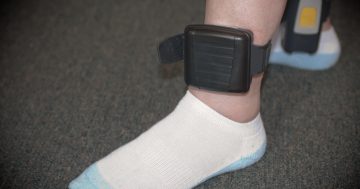
The government says electronic monitoring will broaden the courts’ options. Photo: Michelle Kroll.
Electronic monitoring will become part of the ACT justice system under a staged program, starting with people on existing community-based orders, the ACT Government has announced.
The ACT is the only jurisdiction not to adopt the monitoring technology, commonly in the form of ankle bracelets that can be tracked.
The first stage will include Intensive Correction Orders, parole, limited bail and those on leave permits, followed later by new schemes, such as home detention, early release, post-release supervision, expanded bail and intensive monitoring for domestic and family violence perpetrators.
The government will still need to pass legislation, and fund and procure the technology.
It was a recommendation of the Assembly committee that inquired into the administration of bail that the ACT implement the use of electronic monitoring, especially for alleged and proven domestic violence offenders, and provide a receiver so those at risk from offenders can be alerted to their presence.
The government said it was working closely with domestic family violence stakeholders to navigate the complexities of using electronic monitoring in such cases, including ensuring the safety of victims and assessing risk.
It believed electronic monitoring had great potential to reduce reoffending generally.
Rolling out the system progressively would ensure stakeholders and the community were confident in its effectiveness before it was used for higher-risk offenders.
Implementation of the first stage would require legislative changes and training, resourcing and operational changes for ACT Corrective Services, ACT Courts, the Sentence Administration Board and ACT Policing.
The Justice and Community Safety Directorate would now go to market to seek the best technology and supplier, and determine how much it would cost.
Chief Minister Andrew Barr said electronic monitoring would provide another option for managing people within the justice system.
Mr Barr said it had the potential to reduce incarceration rates and physical reporting requirements for offenders, and improve community safety.
However, the government would move cautiously to build confidence in the system it adopted.
“This first stage will inherently include domestic and family violence perpetrators, but we recognise that assessing and managing risk in this area is complex and we will work with the DFV sector to ensure we address concerns about monitoring perpetrators in the community before electronic monitoring commences,” he said.
“Then, as we build our capacity and confidence in the system, we will look at more intensive domestic and family violence monitoring for higher-risk offenders as part of stage two.”
Attorney-General Shane Rattenbury said electronic monitoring was not a panacea for preventing a person from committing a crime, but it could be a useful tool to identify and respond to breaches of certain community-based orders.
“Adequately funded, proactive wraparound support and timely responses to breaches will be critical to ensuring the Territory has an effective electronic monitoring system,” he said.
Minister for Corrections Emma Davidson said electronic monitoring would help keep victims of crime safer and help in offenders’ rehabilitation.
“Stage one starts with lower-risk individuals, who already have significant supervision and support, before it is expanded to those who might not qualify for community-based orders without electronic monitoring.
“The second stage will focus on new schemes, such as home detention and early release, to help reduce incarceration rates by diverting people to stay in the community and access the services they need to make safer choices in the future – as we have seen in other jurisdictions.”
Minister for Police and Crime Prevention Mick Gentleman said electronic monitoring would be an important tool for police to reduce recidivism and support the reintegration of offenders into the community.
Original Article published by Ian Bushnell on Riotact.











